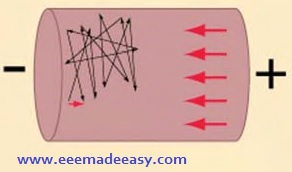
Electron Drift Velocity
The electron moves at the Fermi speed, and has only a tiny drift velocity superimposed by the applied electric field.
Suppose that in a conductor, the number of free electrons available per m3 of the conductor material is n and let their axial drift velocity be ν metres/second.
Basic Physical Concepts of Atom, Nucleus, Proton, electron is detailed in this post in EEE Notebook Read it HERE
Download & Install EEE Made Easy App
In time dt, distance travelled would be ν × dt.
If A is area of cross-section of the conductor, then the volume is νAdt and the number of electrons contained in this volume is νA dt.
Obviously, all these electrons will cross the conductor cross-section in time dt.
If e is the charge of each electron, then total charge which crosses the section in time dt is dq = nAeν dt.
Since current is the rate of flow of charge, it is given as
i = dq / dt
=nAeν dt/dt
∴ i = nAeν
Current density, J = i/A = ne ν ampere/metre2
Assuming a normal current density J = 1.55 × 10^6 A/m2, n = 10^29 for a copper conductor
and e = 1.6 × 10−19 coulomb, we get
1.55 × 10^6 = 10^29 × 1.6 × 10^−19 × ν ∴ ν = 9.7 × 10^−5 m/s = 0.58 cm/min
It is seen that contrary to the common but mistaken view, the electron drift velocity is rather very
slow and is independent of the current flowing and the area of the conductor.
Question:
A conductor material has a free-electron density of 10^24 electrons per metre^3.
When a voltage is applied, a constant drift velocity of 1.5 × 10^−2 metre/second is attained by the
electrons. If the cross-sectional area of the material is 1 cm^2, calculate the magnitude of the current.
Electronic charge is 1.6 × 10^−19 coulomb.
The magnitude of the current is
i = nAeν amperes
Here, n = 1024 ; A = 1 cm2 = 10^−4 m2
e = 1.6 × 10^−19 C ; v = 1.5 × 10^−2 m/s
∴ i = 10^24 × 10^−4 × 1.6 × 10^−19 × 1.5 × 10^−2 = 0.24 A
Charge Velocity and Velocity of Field Propagation
The speed with which charge drifts in a conductor is called the velocity of charge. its value is quite low, typically fraction of a metre per second.
However, the speed with which the effect of e.m.f. is experienced at all parts of the conductor
resulting in the flow of current is called the velocity of propagation of electrical field.
It is independent of current and voltage and has high but constant value of nearly 3 × 10^8 m/s.
Question 2
Find the velocity of charge leading to 1 A current which flows in a copper conductor of cross-section 1 cm2 and length 10 km. Free electron density of copper = 8.5 × 10^28 per m^3. How long will it take the electric charge to travel from one end of the conductor to the other?
Solution. i = neAν or ν = i/neA
∴ ν= 1/(8.5 × 10^28 × 1.6 × 10^−19 × 1 × 10−4) = 7.35 × 10^−7 m/s = 0.735 μm/s
Time taken by the charge to travel conductor length of 10 km is
t = distance/ velocity
= (10×10^3)/(7.35 x10^−7)
= 1.36 × 10^10 s
Now, 1 year = 365 × 24 × 3600 = 31,536,000 s
t = 1.36 × 10^10/31,536,000 = 431 years
Download & Install Job Search India App for daily Job Updates
1.Electron-Mass of electron, Charge of electron, Speed of Electron, value of electron
3. Mass of Electron, proton, neutron|Charge of electron and Proton
- Industries Extension Officer Syllabus Kerala PSC|IEO 2024 Syllabus
- [PDF]Trade Instructor Gr.II Electroplating Syllabus Kerala PSC|92/2023 syllabus
- [PDF] Syllabus Assistant Engineer Electrical Harbour Engineering Kerala PSC
- Industries Extension Officer Kerala PSC Notification|IEO 2024
- Electricity Act 2003 Section 135




